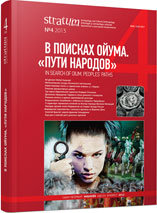Еще раз о нижней дате длинных курганов (история вопроса и ответы оппонентам)
A Contribution to the Lower Date of the Long Barrows (history of investigation and reply to opponents)
Author(s): Sergey Yu. Kargapoltsev Subject(s): History, Archaeology, Middle Ages, 6th to 12th Centuries
Published by: Издательский дом Stratum, Университет «Высшая антропологическая школа»
Keywords: North-Western Russia; South-Eastern Estonia; Forest zone; Great Migration; Lindora-Polibino type sites; Great Migration Epoch; Long Barrows
Summary/Abstract: The author examines the history of study and problems of interpretation of the lower date of the so-called culture of the Pskov Long Barrows (Lindora-Polibino type sites) and also some aspects of their localization on the archaeological map of the North-Western part of the Eastern Europe in the beginning of Great Migration.Relying on a number of his earlier works published in 1980s — 1990s, which are not known to modern investigators (N. Petrov, A. Furas'ev, N. Lopatin, S. Kuzmin, E. Mikhaylova, B. Lyč, S. Popov), the author declines the term «culture of long barrows» which could be used in this case and advises to use a new and more correct term for all sites of South-Eastern Estonia and Pskov Land group. According to the author's opinion, it is — “the Lindora-Polibino type sites”.The text contains main conclusions of author's concept and his reply to the criticisms.Basing on well dated grave goods (belt garnitures, buckles, ornaments, weaponry, elements of harness, etc.) from the cemeteries, discovered in the Central Europe of the Late Roman and Early Migration Periods, phases C1b/C2–D2, the author suggests, that the lower date of burial complexes of the horizon of the Lindora-Polibino type sites is determined as the period from late 4th — first half of 5th centuries AD (375—450).The author abstains from the concrete ethnic definitions for “the Lindora-Polibino type sites”. He points out mixed type of the funeral and material traditions of their bearers (Finnish and Baltic elements with some influences by the military barbarians from the provinces of the Roman Empire). Also the author considers that there are not enough materials (including written sources of the late Antiquity and early Middle Age epochs) to search straight similarities and names for tribes among artificial definitions of archaeological cultures in North-Western part of the Eastern Europe.
Journal: Stratum plus. Археология и культурная антропология
- Issue Year: 2013
- Issue No: 4
- Page Range: 351-359
- Page Count: 9
- Language: Russian
- Content File-PDF

